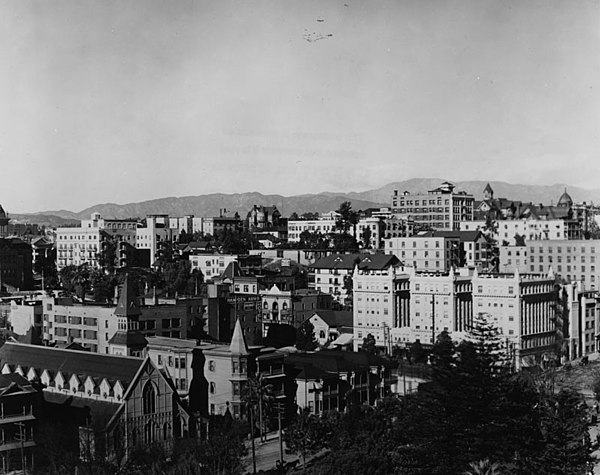Los Angles 's geography part 1
Water from a distance
For its first 120 years, the Los Angeles River supplied the town with ample water for homes and farms. It was estimated that the annual flow could have support a town of 250,000 people—if the water had been managed right. But Angelinos were among the most profligate users of water in the world. In the semi-arid climate, they were forever watering their lawns, gardens, orchards, and vineyards. Later on, they would need more to support the growth of commerce and manufacturing. By the beginning of the 20th century, the town realized it would quickly outgrow its river and need new sources of water.[17]
Legitimate concerns about water supply were exploited to gain backing for a huge engineering and legal effort to bring more water to the city and allow more development. The city fathers had their eyes on the Owens River, about 250 miles (400 km) northeast of Los Angeles in Inyo County, near the Nevada state line. It was a permanent stream of fresh water fed by the melted snows of the eastern Sierra Nevada. It flowed through the Owens River Valley before emptying into the shallow, saline Owens Lake, where it evaporated.
Sometime between 1899 and 1903, Harrison Gray Otis and his son-in-law successor, Harry Chandler, engaged in successful efforts at buying up cheap land on the northern outskirts of Los Angeles in the San Fernando Valley. At the same time, they enlisted the help of William Mulholland, chief engineer of the Los Angeles Water Department (later theLos Angeles Department of Water and Power or LADWP), and J.B. Lippencott, of the United States Reclamation Service.
Lippencott performed water surveys in the Owens Valley for the Service while secretly receiving a salary from the City of Los Angeles. He succeeded in persuading Owens Valley farmers and mutual water companies to pool their interests and surrender the water rights to 200,000 acres (800 km²) of land to Fred Eaton, Lippencott's agent and a former mayor of Los Angeles. Lippencott then resigned from the Reclamation Service, took a job with the Los Angeles Water Department as assistant to Mulholland, and turned over the Reclamation Service maps, field surveys and stream measurements to the city. Those studies served as the basis for designing the longest aqueduct in the world.
By July 1905, the Times began to warn the voters of Los Angeles that the county would soon dry up unless they votedbonds for building the aqueduct. Artificial drought conditions were created when water was run into the sewers to decrease the supply in the reservoirs and residents were forbidden to water their lawns and gardens.[citation needed]
On election day, the people of Los Angeles voted for $22.5 million worth of bonds to build an aqueduct from the Owens River and to defray other expenses of the project. With this money, and with a special Act of Congress allowing cities to own property outside their boundaries, the City acquired the land that Eaton had acquired from the Owens Valley farmers and started to build the aqueduct. On the occasion of the opening of the Los Angeles Aqueduct on November 5, 1913 Mullholland's entire speech was five words: "There it is. Take it."

Comments
Post a Comment